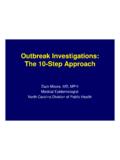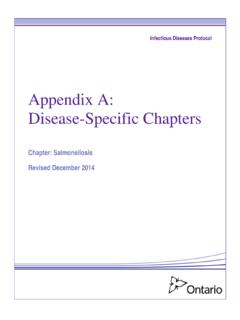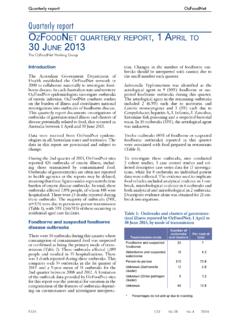Transcription of ASSESSING THE OUTBREAK RESPONSE AND IMPROVING …
1 CHOLERA OUTBREAK . ASSESSING THE OUTBREAK RESPONSE . AND IMPROVING preparedness . world health organization For more information, please contact: CDS Information Resource Centre world health organization CH 1211 Geneva 27. Fax: (+41) 22 791 4285. Email: world health organization GLOBAL TASK FORCE ON CHOLERA CONTROL. WHO/CDS/CPE/ CHOLERA OUTBREAK . ASSESSING THE OUTBREAK RESPONSE . AND IMPROVING preparedness . world health organization , Geneva 2004. GLOBAL TASK FORCE ON CHOLERA CONTROL.. world health organization , 2004. All rights reserved. The designations employed and the presentation of the material in this publication do not imply the expression of any opinion whatsoever on the part of the world health organization concerning the legal status of any country, territory, city or area or of its authorities, or concerning the delimitation of its frontiers or boundaries. Dotted lines on maps represent approximate border lines for which there may not yet be full agreement. The mention of specific companies or of certain manufacturers' products does not imply that they are endorsed or recommended by the world health organization in preference to others of a similar nature that are not mentioned.
2 Errors and omissions excepted, the names of proprietary products are distinguished by initial capital letters. The world health organization does not warrant that the information contained in this publication is complete and correct and shall not be liable for any damages incurred as a result of its use. Contents Introduction .. 5. Cholera general .. 7. 1. OUTBREAK detection .. 10. Keywords: early detection rapid verification and RESPONSE 2. OUTBREAK confirmation .. 14. Keywords: case definition laboratory confirmation 3. organization of the RESPONSE .. 18. Keywords: cholera coordination committee plan of action 4. Management of the information .. 23. Keywords: clarifying rumours partnership with media 5. Case management: treatment .. 26. Keywords: assessment of the patient rehydration education 6. Reduction of mortality .. 31. Keywords: cholera treatment units supplies training of professionals 7. Hygiene measures in health care facilities .. 36. Keywords: isolation of patients disinfection hand-washing 8.
3 Involvement of the community to limit the spread of the disease .. 40. Keywords: health education appropriate messages cultural acceptability 9. Control of the environment: safe water .. 44. Keywords: chlorination water quality testing boiling water 10. Control of the environment: safe food .. 48. Keywords: preparation of food hygiene in marketplaces . cooked food 11. Control of the environment: sanitation .. 51. Keywords: improved sanitation education on hygiene 12. Funeral practices .. 54. Keywords: hygienic handling of corpses restrictions on feasts 13. Surveillance .. 57. Keywords: information for action descriptive epidemiology 14. Involvement of international partners .. 62. Keywords: project proposals coordination of international partners Appendices 1. Tool for evaluation .. 66. 2. Outline of the assessment report .. 68. 3. Essential rules in a cholera treatment unit .. 70. 4. Chlorine dilution according to use .. 72. 5. Methods for household water treatment.
4 74. 6. Key messages for health education .. 76. 7. Preparation and use of the 1% chlorine stock solution to disinfect water .. 80. 8. Rules for safe preparation of food to prevent cholera .. 82. 9. Matrix for coordination of cholera control activities .. 84. References .. 86. CHOLERA OUTBREAK RESPONSE . 4. Introduction OBJECTIVES. Cholera OUTBREAK RESPONSE generally focuses on medical aspects that are important for lowering mortality. However, a more comprehensive RESPONSE is needed to limit the spread of the disease. As the OUTBREAK RESPONSE is often led by medical professionals, other aspects, such as environmental or com- munication issues, might tend to be neglected. This document offers a framework for the assessment of a cholera OUTBREAK RESPONSE , which will help to: provide a comprehensive overview of the OUTBREAK RESPONSE ;. pinpoint the main strengths and weaknesses of the RESPONSE ;. improve preparedness for and RESPONSE to future outbreaks;. provide accurate recommendations based on WHO official guidelines.
5 It is intended primarily for: technical staff of ministries of health ;. health professionals in WHO country offices;. consultants responsible for undertaking a cholera OUTBREAK assessment. CHOLERA OUTBREAK RESPONSE . 5. Introduction WHEN CAN IT BE USED? 1. Detection This document can be used at the end of the OUTBREAK , for 2. Confirmation retrospective evaluation which is essential to plan for improved 3. RESPONSE prevention and RESPONSE in the future. Additional tools are given in Appendices 1 and 2 to help with the evaluation report. 4. Information The document can also be used during an OUTBREAK to check 5. Treatment whether any of the aspects of cholera control has been 6. Mortality overlooked. 7. Hygiene 8. Community 9. Water STRUCTURE OF THE DOCUMENT. 10. Food The document contains a general section on cholera, plus 14. 11. Sanitation technical sections, each with the following format: 12. Funeral Keywords reflecting the principal topic(s) covered. 13. Surveillance Assessment of the OUTBREAK listing the questions that should 14.
6 Partners be addressed during the evaluation. A-1 Useful comments for improved preparedness particularly A-2 useful if there are recurrent outbreaks of cholera on a A-3 seasonal basis (usually in the rainy season). A-4 Tips highlighting the main issues relating to cholera A-5 outbreaks. A-6. A-7. A-8. A-9. CHOLERA OUTBREAK RESPONSE . 6. Cholera general Cholera is a diarrhoeal disease caused by infection of the intestine with the bacterium Vibrio cholerae, either type O1. or O139. Both children and adults can be infected. About 20% of those who are infected develop acute, watery diarrhoea 10 20% of these individuals develop severe watery diarrhoea with vomiting. If these patients are not promptly and adequately treated, the loss of such large amounts of fluid and salts can lead to severe dehydration and death within hours. The case-fatality rate in untreated cases may reach 30 50%. Treatment is straightforward (basically rehydration) and, if applied appropriately, should keep case-fatality rate below 1%.
7 Cholera is usually transmitted through faecally contaminated water or food and remains an ever-present risk in many coun- tries. New outbreaks can occur sporadically in any part of the world where water supply, sanitation, food safety, and hygiene are inadequate. The greatest risk occurs in over-populated communities and refugee settings characterized by poor sanitation, unsafe drinking-water, and increased person-to- person transmission. Because the incubation period is very short (2 hours to 5 days), the number of cases can rise extremely quickly. CHOLERA OUTBREAK RESPONSE . 7. Introduction It is impossible to prevent cholera from being introduced into 1. Detection an area but spread of the disease within an area can be prevented through early detection and confirmation of cases, 2. Confirmation followed by appropriate RESPONSE . Because cholera can be an 3. RESPONSE acute public health problem with the potential to cause many 4. Information deaths, to spread quickly and eventually internationally, and to 5.
8 Treatment seriously affect travel and trade a well coordinated, timely, and effective RESPONSE to outbreaks is paramount. 6. Mortality 7. Hygiene RESPONSE activities should always be followed by the planning and implementation of preparedness activities that will allow 8. Community future cholera outbreaks to be dealt with more effectively. 9. Water A strong cholera preparedness plan and programme is the best 10. Food preparation for outbreaks in countries at risk of cholera, whether 11. Sanitation or not they have yet been affected, or countries in which seasonal recurrence of the disease may be expected. 12. Funeral 13. Surveillance 14. Partners NEW STRATEGIES: ORAL CHOLERA VACCINES. A-1 In the long term, improvements in water supply, sanitation, food A-2 safety and community awareness of preventive measures are A-3 the best means of preventing cholera, as well as other diarrhoeal diseases. However, WHO is currently evaluating the use of newer A-4. tools to complement these traditional measures.
9 Oral cholera A-5 vaccines of demonstrated safety and effectiveness have recently A-6 become available for use by individuals. Some countries have A-7 already used oral vaccine to immunize populations considered A-8. A-9. CHOLERA OUTBREAK RESPONSE . 8. to be at high risk for cholera outbreaks. Use of these vaccines in both endemic and epidemic situations requires further assessment. Work is under way to investigate the role of mass vaccination as a public health strategy for protecting at-risk populations against cholera. Issues being addressed include logistics, cost, timing, vaccine production capacity, and criteria for the use of mass vaccination to contain and prevent outbreaks. CHOLERA OUTBREAK RESPONSE . 9. Introduction 1. OUTBREAK detection 1. Detection 2. Confirmation 3. RESPONSE KEYWORDS. 4. Information EARLY DETECTION RAPID VERIFICATION AND RESPONSE . 5. Treatment 6. Mortality 7. Hygiene ASSESSMENT OF THE OUTBREAK . 8. Community 1. How were the first cases notified to health authorities (through 9.)
10 Water surveillance system, media release or radio announcements, informal sources, other)? 10. Food 11. Sanitation Are the communication channels for reporting cases well established in regions or municipalities? 12. Funeral 13. Surveillance 2. At the beginning, what alerted people to the possibility of an OUTBREAK : 14. Partners a sudden occurrence of the disease? A-1 a persistent increase in reported cases A-2 (over a period of more than one week)? A-3 a sudden increase in the number of cases? an abnormal number of deaths? A-4. A-5 3. On what basis was it decided that this was an OUTBREAK : a single case? A-6. a cluster of cases? A-7 case incidence greater than expected (compared with A-8 the same period of time in previous years)? A-9. CHOLERA OUTBREAK RESPONSE . 10. 4. How long did the information take to reach decision-making level from the area where the OUTBREAK occurred? (It should not be more than one week.). 5. What were the first actions taken at the central level: telephone call to the affected areas to verify rumours?















